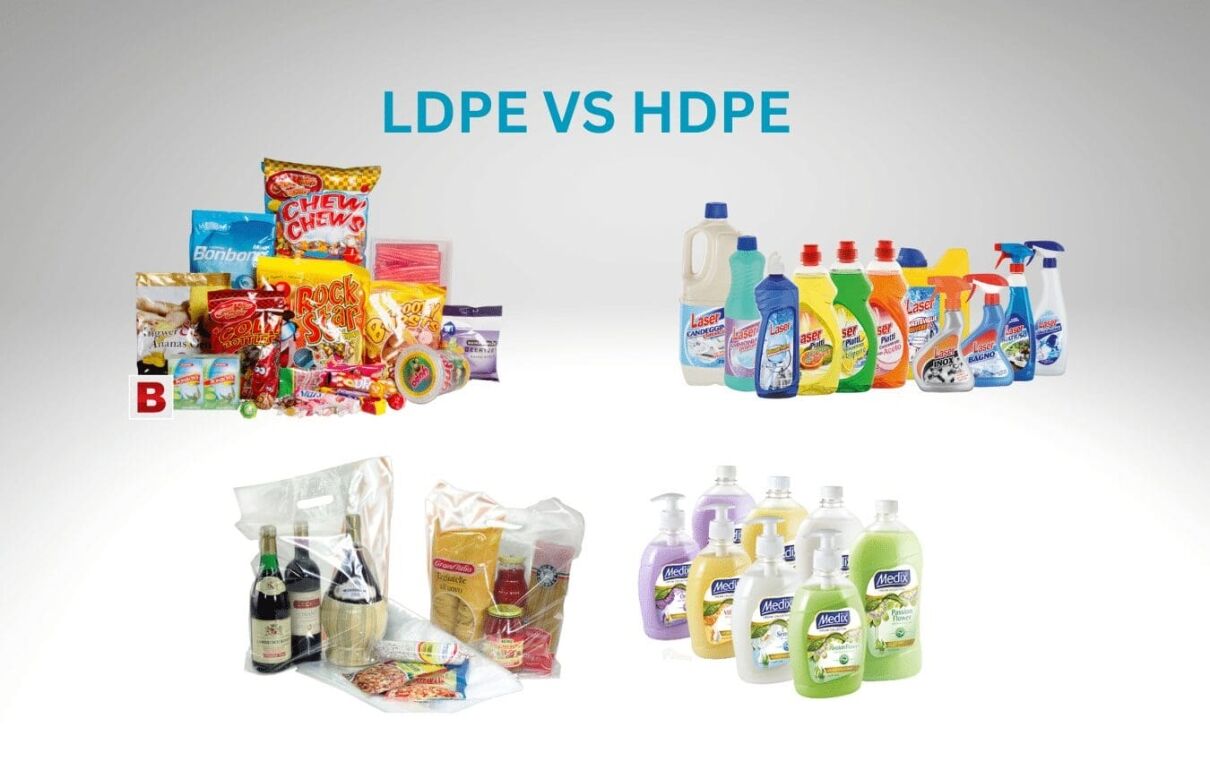Home » High Density and Low-Density Polyethylene Explained: Packaging Applications & Benefits
High Density and Low-Density Polyethylene Explained: Packaging Applications & Benefits

High density polyethylene (HDPE) and low-density polyethylene (LDPE) are both types of polyethylene, a thermoplastic polymer made from petroleum. The main difference between the two is the density of the material. HDPE has a higher density and a higher molecular weight, while LDPE has a lower density and a lower molecular weight.
HDPE Packaging Applications
In terms of packaging applications, HDPE is commonly used for making rigid containers like milk jugs, water bottles, and plastic drums. It is also used in the manufacturing of pipes and fittings for the transportation of gas and water. HDPE is known for its strength and durability, making it a popular choice for packaging products that need to withstand rough handling or transportation. It also has good chemical resistance, making it suitable for packaging products that may come into contact with chemicals.
Benefits of HDPE
Benefits of HDPE include: High strength, high stiffness, good chemical resistance, good impact resistance and good temperature resistance. Disadvantages of HDPE include: It is less flexible, difficult to print on and is more prone to cracking under stress.
LDPE Packaging Applications
On the other hand, LDPE is commonly used in packaging applications such as plastic wraps, food storage bags, and squeezable bottles. Its flexibility and versatility make it a good choice for packaging products that need to be flexible, such as bags and films. It is also used to make plastic films for packaging and in the electrical and electronic industries. LDPE’s flexibility is also an advantage for packaging products that need to be vacuum-sealed or shrink-wrapped.
Benefits of LDPE
Benefits of LDPE include: Its flexibility and versatility, good electrical insulation, good chemical resistance, and low cost. Disadvantages of LDPE include: it is less stiff, less strong and has lower temperature resistance, and is more likely to crack and wear over time.
Which one should you choose?
When deciding whether to use HDPE or LDPE for packaging, it is important to consider the properties of the product being packaged and the specific requirements of the packaging. For example, if the product requires a strong and durable container that can withstand rough handling or transportation, HDPE would be a good choice. On the other hand, if the product requires a flexible and versatile packaging that can be vacuum-sealed or shrink-wrapped, LDPE would be a better choice. Additionally, if you’re looking for a printing option on the packaging, HDPE may not be ideal as it can be difficult to print on.
If you are interested in HDPE or LDPE material packaging products, then contact Brown Packaging today. We can offer our clients a wide selection of flexible packaging options and customization.
Why Co-Packaging Becomes Critical During the Holidays As the holiday season approaches, packaging teams are under pressure to deliver high volumes of promotional sets, combo
Holiday demand starts long before December. So should your packaging. For B2B and D2C brands alike, Q4 is the most critical—and most chaotic—shipping window of
The Challenge of Multi-SKU Holiday Programs During the holiday season, brands often shift from selling single products to curated sets, bundled assortments, and promotional kits—each
Rigid boxes are the gold standard of premium packaging. Whether used for cosmetics, electronics, fashion, or high-end subscription kits, rigid boxes do more than protect
Understanding One-Piece FOL and Three-Piece Bike Shipping Boxes Choosing the right box style is essential when shipping bicycles—especially for brands, manufacturers, and distributors focused on
Corrugated boxes are essential to shipping, retail, and e-commerce—but when you introduce custom printing, the stakes (and the opportunities) rise. Print isn’t just about looks—it’s
Home » High Density and Low-Density Polyethylene Explained: Packaging Applications & Benefits
California has long been a pioneer in environmental protection, and its stringent packaging laws are a testament to its commitment to sustainability. Among these regulations,
In the dynamic and ever-evolving food industry, packaging plays a pivotal role in preserving the quality, safety, and freshness of products while also captivating consumers
Poly bags are a staple in the packaging industry, offering a lightweight, cost-effective, and versatile solution for packaging various products, from food and consumer goods